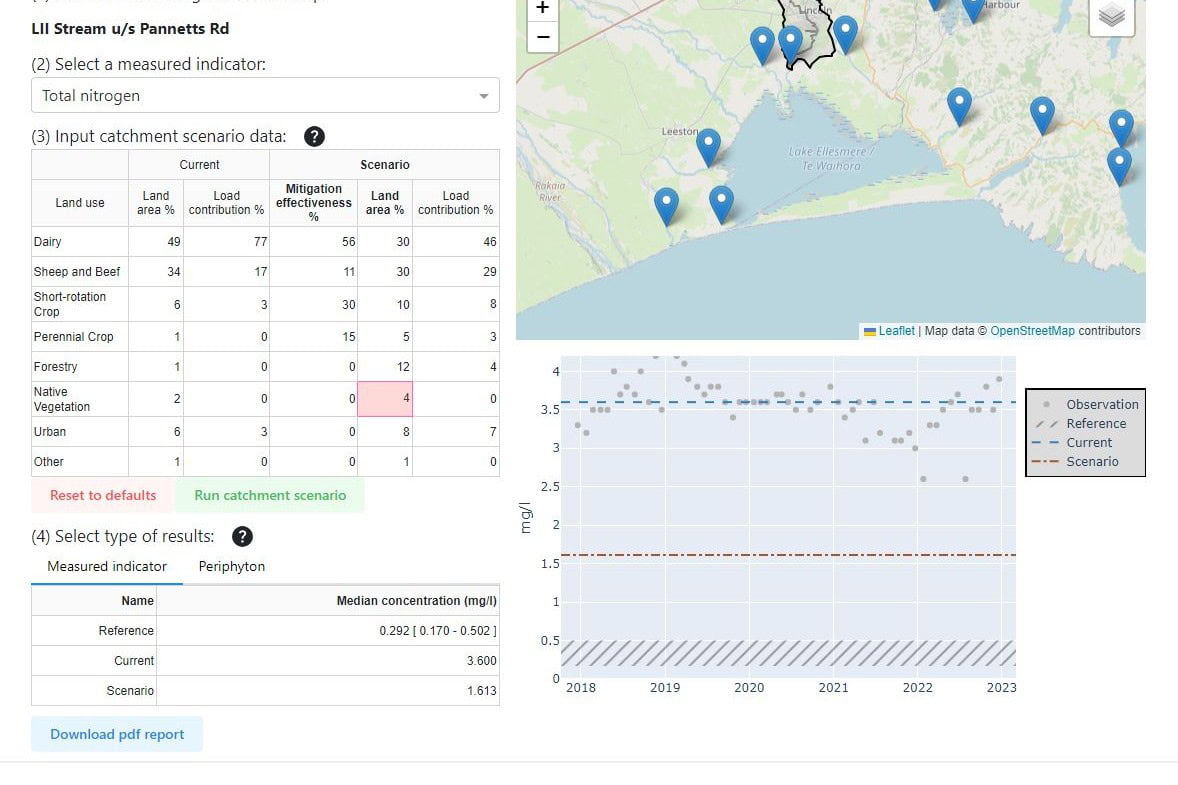August 30, 2024
-
- About UsMā mātou
- Our ScienceTe pūtaiao
- Future Landscapes Ngā Horanuku AnamataIn the future, landscapes will contain mosaics of land use that are more resilient, healthy and prosperous than today.
- Assessing Contaminants with Stream Order
- Benign Denitrification in Groundwaters
- Cascade of Soil Erosion
- Connecting Soil and Water Quality
- Crop Disease Under Climate Change
- Faecal Source Tracking
- Healthy Estuaries
- Innovative Agricultural Microbiomes
- Interoperable Modelling
- Land Use for Nutritious Diets
- Land Use Opportunities
- Land Use Suitability
- Linking Legacies to Wai
- Mapping Freshwater Contaminants
- Matarau: Empowering Māori Landowners in Land Use Decisions
- Measuring Denitrification
- Monitoring Freshwater Improvement Actions
- Mosaic vs Monoculture Landscapes
- Next Generation Systems
- Pasture for Humans
- Peri-Urban Potential
- Phosphorus Best Practice
- Physiographic Environments of New Zealand
- Pohewa Pae Tawhiti
- Protein Future Scenarios
- Silvopastoral Systems
- Sources and Flows
- Visualising Forestry Harvesting Cycles
- Incentives for Change Ngā Poapoa PanoniWe want to reward New Zealand’s primary producers for producing high-value products in sustainable ways.
- Aotearoa Food Cultures
- Appropriate Use of Taonga Species
- Credence Attributes On Farm
- Early Māori Agricultural Entrepreneurship
- EU Green Deal: Impact on NZ Exports
- Eutrophication Product Footprinting
- Impact of Imported Feed Shortages
- Incentives for Data Sharing
- Indicators Working Group
- Integrating Value Chains
- Kaitiaki Intelligence Platforms
- Kuaha Matihiko: Digital Gateway
- Measuring Full Impacts of Land-Use Change
- New Models of Collective Responsibility
- Options for Rural Investment
- Reasons for Water Quality Improvement
- Regenerative Agriculture
- Register of Land Management Actions
- Rewarding Sustainable Practices
- Signals for Land Stewards
- The Matrix of Drivers
- Workforce Implications of Land-Use Change
- Pathways to Transition Ngā Ara WhakawhitiWe are growing understanding of what it takes to transition to resilient, healthy and prosperous futures, and are developing tools to help.
- Connecting Food Producers & Consumers
- Diverse Experiences of Farming
- Enhancing Assurance Schemes
- Future Scenarios for Arable Agriculture
- Implementing Te Mana o Te Wai
- Land-Use Scenarios for Nikau Farm
- Lessons from Our Land and Water
- Mauri Whenua Ora
- Ngā Tai-o-Rongo
- Predicting Agricultural Research Adoption
- Retiring Farmland into Ngahere
- Revitalise Te Taiao
- Rural Professionals Fund 2020–21
- Rural Professionals Fund 2021–22
- Rural Professionals Fund 2022–23
- Rural Professionals Fund 2023–24
- Science in Freshwater Policy Development
- Shared Vision for Land Use in Marlborough
- Storying Kaitiakitanga
- Synthesis Scenarios for Future Land Use
- The Collaboration Lab
- Trust and Social Licence
- Urban-Rural Partnerships for Equal Change
- Whenua Life Values
- Future Landscapes Ngā Horanuku AnamataIn the future, landscapes will contain mosaics of land use that are more resilient, healthy and prosperous than today.
- News + EventsHe pānui
- Resources Ngā rauemi
- View by topic
- Climate Change
- Collaboration
- E.coli
- Farm Environment Plans
- Farm Management
- Farming for Good
- Increasing Value
- Irrigation
- Land-Use Change
- Measuring Water Quality
- Mitigation
- Nitrogen
- NPS-FM
- Nutrient Management
- Phosphorus
- Regenerative Agriculture
- Sector Transformation
- Sediment
- Social Licence
- Te Ao Māori
- Te Mana o Te Wai
- Winter Grazing
- View by topic
- Outcomes Ngā puawaitanga
Resources related to
NPS-FM
You are here: Home Topics NPS-FM
The National Policy Statement for Freshwater Management came into effect in 2020. Some of the resources below contributed to policy development, and others can be used to support implementation of the new regulations.
Showing 1 - 12 of 108 results
Technical Report
Evaluation of the physiographic method for the Tasman Region
The work undertaken in this project provides Tasman District Council with a foundation for which the physiographic approach can be applied within the region. The…
Technical Report
Advice for application of the physiographic method to the West Coast Region
Land and Water Science Ltd. was contracted to provide services to West Coast Regional Council through an Envirolink Small Advice Grant. The aim of the…
Guidance
Towards a Physiographic Map: Information for Regional Councils
Physiographic Environments of New Zealand research is developing a cost-effective technique to measure and map (as an integrated physiographic layer) how features of the natural…
Technical Report
Application of Physiographic Science to the Northland Region: Preliminary Hydrological and Redox Process-Attribute Layers
Water quality outcomes can vary spatially across the landscape, even when there are similar land use pressures. These differences are often the result of natural…
Technical Report
Essential freshwater: Impact of existing periphyton and proposed dissolved inorganic nitrogen bottom lines
This report for the Ministry for the Environment applies methods developed in the LUS research programme to help resource management professionals understand the implications of…
Method
A Heuristic Method for Determining Changes of Source Loads to Comply with Water Quality Limits in Catchments
A common land and water management task is to determine where and by how much source loadings need to change to meet water quality limits…
Journal Article
Nitrogen loads to New Zealand aquatic receiving environments: Comparison with regulatory criteria
There is concern about the deteriorating nutrient status of aquatic receiving environments in New Zealand. We estimated the amount by which current nitrogen (N) concentrations…
Summary
Assessing the Effectiveness of On-Farm Mitigation Actions
This research summary describes how effective on-farm mitigations have been so far, by comparing losses of nitrogen (N), phosphorus (P) and sediment in 1995 and…
Journal Article
Implications of water quality policy on land use: A case study of the approach in NZ
Achieving good water quality through output controls is difficult. The New Zealand Government recently proposed enforceable bottom lines to protect ecosystem health of 1 mg…
Interactive Tool
Map of Total Nitrogen Excess and Reduction Potential
An interactive map shows the total nitrogen (TN) in excess of current national rules and the potential for mitigation strategies to reduce TN losses from…
Summary
Quantifying Excess Nitrogen Loads in Fresh Water
At least 43% of New Zealand’s agricultural land (31% of New Zealand’s total land area) is in catchments that are under pressure (‘pressure’ meaning the…
Video
What the data tells us about our water
By bringing together multiple data sources, we can now see which catchments are under the most pressure, and whether applying all known and emerging on-farm…
 View Our Strategy Document 2019 – 2024
View Our Strategy Document 2019 – 2024


